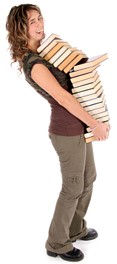Organizing a Storage Area
How you choose to organize a storage area will depend on its size, configuration, location, and purpose you have chosen for the space. While many people rent separate storage units away from home, most homeowners devise storage space in attics, cellars or basements, garages, closets, pantries, and outbuildings, and the location and accessibility of the space are important factors in deciding what to store where.
If the space holds a single type of item, it may be organized differently than if there are multiple types of items. Similarly, if there are items with great differences in their size, weight, fragility, shelf-life, importance, or frequency of use, this will affect choices you make in choosing the location and arranging the area.
Be sure to consider the humidity and temperature and the possibility of pests in the storage area when deciding what to store where, as well.
Items that are frequently stored in households include the following:
- • holiday ornaments
• seasonal sports gear and equipment and yard games
• seasonal clothing
• clothing, toys, furniture and other items used by older children and being saved for younger children in the household
• home-canned food and/or food storage
• seasonal upholstery, bedding, towels, curtains, rugs, etc.
• extra sets of linens, china, flatware, etc.
• items being saved for indeterminate future use, such as furniture.
• extra material for home improvement or maintenance, such as matching wallpaper, paint, stain, etc.
Tips for organizing
Some general tips for organizing may be helpful in setting up or reorganizing your storage area.
 • Be sure to clearly label boxes/bins with permanent marker on labels that will stay in place. Clearly labeled items in storage save wasted time rummaging through boxes.
• Be sure to clearly label boxes/bins with permanent marker on labels that will stay in place. Clearly labeled items in storage save wasted time rummaging through boxes.
• For items that must be stored in boxes, consider using clear plastic "totes" or bins so they can clearly be identified without having to open the bin.
• If you are storing material that needs to be rotated (like food), make arrangements that allow for this. This includes a checklist kept nearby to track rotations and expiration dates. The items should be fairly easy to access.
• If you are storing material that needs ventilation, allow for this.
• Begin with whatever takes the most space and is used most frequently. Group those items with like items, if there are any and set aside.
• If the space includes the possibility of having rows of items one behind the other, such as with cans, start by considering which things are least likely to be needed and place the least needed ones in the least easy to reach spots, whether this is up or down for you. You may wish to make a little map showing the placement of all items, important items, or categories of items, and attach it to the inside of the door (if there is one) or some other visible and accessible place for easy reference.
• If there will be only one layer (i.e., if everything will be visible), start with the items that are most important to have easily accessible and place them in easily accessible places, working out to less accessible space and less frequently needed items.
• Place heavy objects at a low level, and light objects higher up.
• Consider keeping a flashlight in the storage area if it is necessary to locate items in emergency/power outage situations.
• Decide whether any items need to be located in a particular part of the storage area for any important reason. For example:
- • items that should be close to the door
• items that need to be taken out in groups
• items that are needed in a particular order
The following types of storage may be useful:
- • Cupboards
• Closed trash cans lined with plastic for moisture-proof storing.
• Hooks either put into the walls or into a pegboard rack.
• Shelves
• Small sets of drawers for storing small amounts of small items.
• Buy or build any additional storage that you need, and place items where you want them to be.
• Make adjustments due to size, weight, and accessibility as needed.
Written by Mary Elizabeth
Related Home Institute Articles
